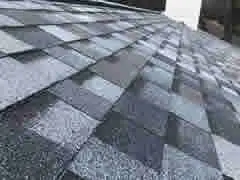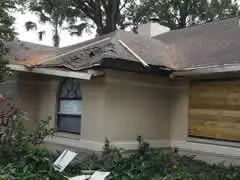Who Replaces Fascia on a House?
Roofers, carpenters, and general contractors replace fascia on a house. Roofers often do this work because of their roofing expertise. Carpenters are good for replacements, especially if wood needs repair. General contractors handle fascia work as part of larger home projects.
Hire a professional experienced with fascia for best results. They can spot issues like water damage or pests. These issues can lead to costly repairs. Contractors might also check your soffit and rain gutters.
Homeowners insurance might cover fascia replacement if wind or hail caused the damage. Check your policy for coverage details. Sealant helps protect new fascia from water. UPVC fascia is another option to explore.
What are Fascia and Soffit, and What is Their Function?
Fascia and soffit protect a home’s roof from water damage and pests. Fascia is a board along the roof’s lower edge, capping rafter tails and supporting shingles. It often holds rain gutters. Soffit covers the underside of the roof overhang, bridging siding and the roof edge. This protects rafters and blocks pests like birds and insects. Proper soffit also ventilates the attic, preventing moisture that can damage the roof. Replacing damaged fascia and soffit maintains roof integrity and prevents costly repairs. Roofers or contractors replace fascia, especially if there is wood rot or water damage. Ignoring damaged fascia can lead to bigger issues with the roof and siding. Homeowners insurance may cover replacement if damage is from a covered event.
Who Should I Hire for Fascia Repair or Replacement: Roofer, Carpenter, or General Contractor?
Hire a roofer, carpenter, or general contractor to replace fascia, depending on damage and project size. Roofers are suited if fascia damage links to roof leaks or shingle issues. Carpenters excel at wood fascia repairs, fixing rot or pest damage. A general contractor is best for projects involving siding, soffit, or gutters.
Choose a roofer if damage is near the roofline; they understand how fascia and the roof prevent water damage. For rot or structural problems, a carpenter offers precise wood repairs. A general contractor streamlines projects, including gutters or siding replacement. Get three quotes to compare costs and experience. Homeowners insurance may cover fascia replacement if a covered event caused the damage.
What are the Common Signs and Causes of Fascia Damage (Rot, Water Damage, Pests)?
Fascia damage appears through rot, water damage, and pests. Wood fascia rots if wet. Clogged gutters cause water to sit against wood, causing rot. Pests like carpenter ants, termites, squirrels, and birds nest in or eat the wood.
Wood rot shows as soft or crumbly spots. Paint bubbles signal trapped moisture. Poor gutters let water run down the fascia.
Regular checks spot problems early. Fixes now avoid big costs later. Replace bad sections with water-resistant polyvinyl chloride (PVC). A roofer or carpenter can fix fascia. Homeowners insurance might cover water damage to fascia.
How Much Does Fascia Replacement Cost, and What Materials Are Used?
Fascia replacement costs vary based on damage, material, and labor, from $6 to $20 per linear foot. Wood and PVC are common choices. Wood fascia needs proper sealant to avoid water damage and pests. PVC resists moisture and pests, saving money in the long run.
Total costs include old fascia removal, surface prep, and new material install. Water damage to soffit or roof shingles raises expenses. Homeowners insurance might cover costs if a storm or other covered event caused the damage. Roofers or contractors handle fascia replacement. Consider gutter condition; damaged gutters often need replacement during fascia work.
Can I DIY Fascia Repair, or Should I Hire a Professional?
You can DIY fascia repair, or you should hire a professional, based on your skill and damage size. Minor repairs are DIY-friendly if you’re comfortable working at heights and have carpentry skills. However, hire a roofer or contractor for significant rot or water damage. Professionals can also handle jobs near electrical wires or needing special tools. Ignoring leaky gutters causes repeat problems, which pros can fix. Improper DIY install leads to costly repairs. Weigh risks; professional fascia replacement ensures correct work and saves money.
How Do You Replace Roof Fascia?
You replace roof fascia by first removing gutters and any damaged shingles. Next, remove the old fascia and check the wood for rot. If the wood is damaged, replace it before putting up the new fascia.
To install the new fascia, measure and cut it to fit. Put sealant on the back where it touches the roof. Nail the fascia to the rafter tails using galvanized nails. Then, reattach the gutters and replace shingles you took off. Consider PVC fascia; it handles water and pests better than wood. Homeowners insurance may pay for fascia replacement if a covered event caused the damage. A roofer or carpenter can replace fascia.
What Role Do Gutters Play in Fascia Health and Preventing Water Damage?
Gutters protect fascia by channeling water away from the roof. Without gutters, rainwater soaks the fascia, which leads to wood rot and attracts pests like carpenter ants.
Well-maintained gutters direct water into downspouts, which prevents water from seeping behind the fascia and damaging the structure or soffit. Regular gutter cleaning is key because clogged gutters cause overflow and water damage. Ignoring gutter maintenance can necessitate hiring a roofer or carpenter for fascia replacement. Homeowners insurance may cover sudden water damage, but not damage from neglect. Replacing damaged fascia prevents further structural issues and pest infestations.
Does Homeowners Insurance Cover Fascia Replacement?
Homeowners insurance may cover fascia replacement, but it depends on the cause of the damage. Insurance often covers replacement if the fascia is damaged by a covered peril, such as wind or a fallen tree. However, it typically does not cover replacement due to normal wear and tear or lack of maintenance.
If water damage from a leaky roof or gutters causes the fascia to rot, your insurance company might deny the claim. Similarly, if pests like insects or rodents damage the fascia, replacement is usually not covered. Review your policy carefully to understand what is included. You may need to pay for the fascia replacement yourself if the damage is not covered.
How Can I Prevent Pest Infestation and Water Damage to My Fascia?
To prevent pest infestation and water damage to your fascia, keep rain gutters clean so water doesn’t overflow and harm the wood. Seal cracks or holes in the fascia to block pests and water.
Inspect your fascia regularly for soft spots or discoloration to find problems early. Trim trees near the roof; this prevents pests from using them to reach the fascia.
Consider UPVC fascia, as it resists water and pests better than wood. Pest control services can also protect your home. Addressing these issues early saves money on home repair. A roofer or contractor can replace damaged fascia if needed. Homeowners insurance might cover fascia replacement due to water damage.



